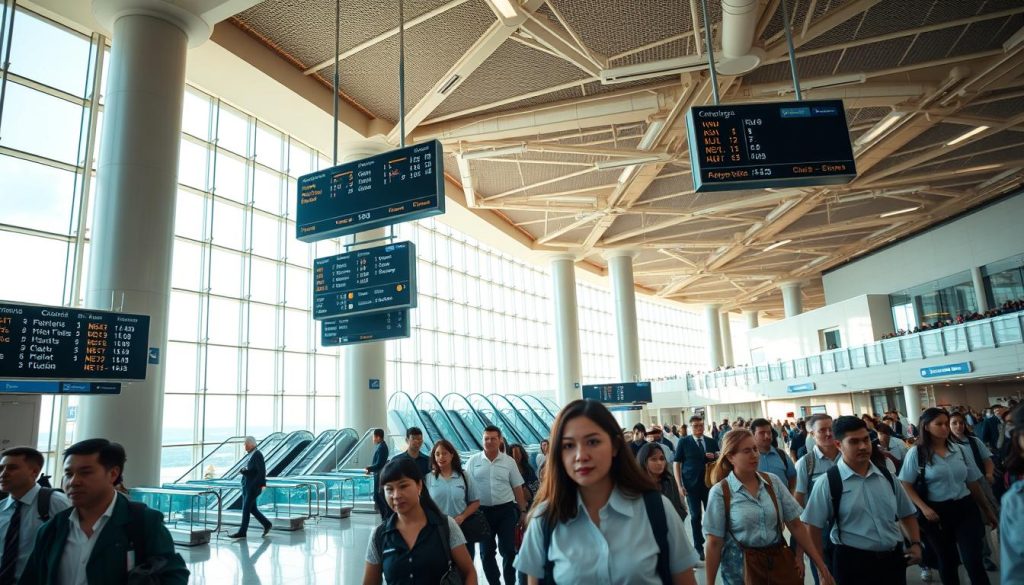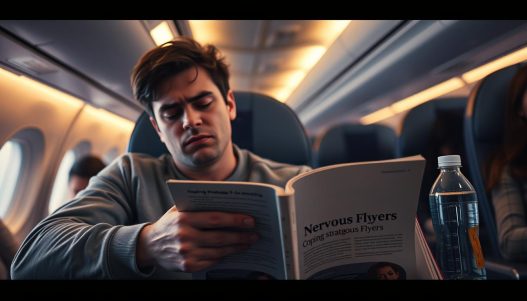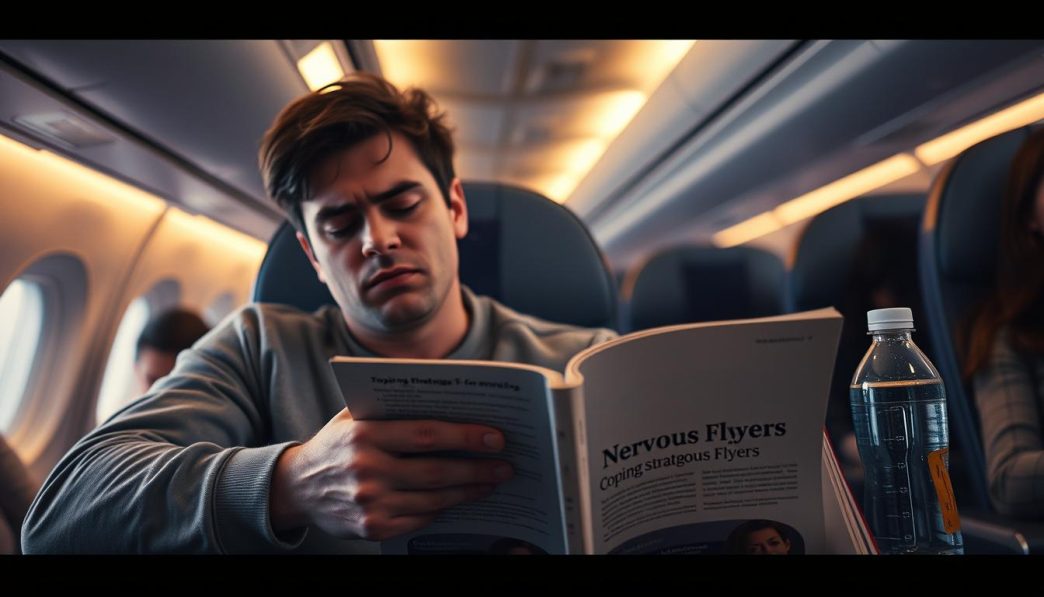For many, flying is a source of significant stress, triggering travel anxiety that can be overwhelming. The thought of boarding a plane can evoke feelings of unease, making it challenging for nervous flyers to enjoy their journey or even step onto a flight.
Understanding the need for coping strategies is crucial. By acknowledging the root causes of travel anxiety, individuals can begin to find solace in techniques designed to calm the nerves and make flying a more pleasant experience.
This article aims to explore various methods to alleviate travel anxiety, providing nervous flyers with the tools necessary to manage their fears and enjoy a more relaxed journey.
Key Takeaways
- Understanding the causes of travel anxiety
- Exploring effective coping mechanisms
- Learning relaxation techniques for flying
- Practical tips for managing flight fears
- Strategies for a more enjoyable flying experience
Understanding Flight Anxiety: Why So Many People Fear Flying
Flight anxiety is not just about being nervous; it’s a physiological response to the stresses of flying. This condition affects a significant portion of the population, causing discomfort and distress during air travel.
The Science Behind Flight Anxiety and Your Body’s Response
The human body is wired to respond to perceived threats, and flying can trigger this response due to factors like turbulence, takeoff, and landing. The body’s “fight or flight” response is activated, releasing stress hormones like adrenaline and cortisol.
This physiological reaction can manifest as rapid heartbeat, sweating, and trembling. Understanding that this response is normal and not a sign of weakness is crucial.
Common Triggers That Make Even Seasoned Travelers Nervous
For many, turbulence is the most anxiety-provoking aspect of flying. Other triggers include takeoff and landing, fear of crashing, and claustrophobia. Past experiences and media coverage of aviation incidents can also exacerbate flight anxiety.
Recognizing these triggers is the first step towards managing them. By understanding the root causes of flight anxiety, individuals can begin to develop strategies to cope with their fears.
Travel Anxiety: Coping Strategies for Nervous Flyers
Coping with flight anxiety requires a multi-faceted approach that includes immediate relief and long-term management strategies. Understanding the difference between these approaches is crucial for developing an effective anxiety management plan.
Immediate Relief vs. Long-term Management Approaches
Immediate relief techniques are designed to provide quick comfort during a flight. These can include deep breathing exercises, progressive muscle relaxation, and grounding techniques. On the other hand, long-term management involves strategies that, over time, reduce the overall anxiety experienced when flying.
Creating Your Personalized Flight Anxiety Management Plan
To create a personalized plan, it’s essential to first identify your specific anxiety triggers and then choose the coping strategies that best address these triggers. This might involve combining immediate relief techniques with long-term management approaches. As
“The greatest glory in living lies not in never falling, but in rising every time we fall.” – Nelson Mandela
By adopting a proactive and tailored approach, nervous flyers can significantly reduce their travel anxiety.
By understanding and leveraging both immediate relief and long-term management strategies, individuals can develop a comprehensive plan to manage their flight anxiety effectively.
Pre-Flight Preparation: Setting Yourself Up for Success
Effective pre-flight preparation can be the key to a stress-free flying experience. By taking a few strategic steps, you can significantly reduce your travel anxiety and make your journey more enjoyable.
Choosing the Right Flight Time and Seat Location
Selecting the right flight time and seat can make a big difference. Consider flying during less busy times, such as early morning or late evening, as these flights tend to be less crowded. When it comes to seat selection, opting for a window seat can provide a sense of security and allow you to lean against the window for support. Alternatively, seats near the front of the plane tend to experience less turbulence.
Essential Items for Your Carry-on Anti-Anxiety Kit
Assembling a carry-on anti-anxiety kit can be a game-changer. Include items such as:
- A stress ball or fidget toy to release tension
- Calming essential oils like lavender in a travel-sized bottle
- A noise-canceling headset or earplugs to block out disturbing sounds
- A comforting item, like a favorite scarf or small blanket
The 24 Hours Before: Sleep, Nutrition, and Hydration Tips
In the 24 hours leading up to your flight, prioritize rest, nutrition, and hydration. Aim for 7-8 hours of sleep to ensure you’re well-rested. Eat balanced meals rich in complex carbohydrates, lean proteins, and healthy fats to stabilize your mood. Stay hydrated by drinking plenty of water, and avoid excessive caffeine and alcohol, which can exacerbate anxiety.
By following these pre-flight preparation tips, you can set yourself up for a more relaxed and enjoyable flying experience.
Airport Navigation: Reducing Stress Before Boarding
Effective airport navigation can significantly reduce travel anxiety. By understanding how to manage your time, navigate security checks, and find quiet spaces within the airport, you can make your pre-flight experience much less stressful.
Time Management: Arriving Early
Arriving at the airport with plenty of time to spare is crucial. It allows you to check-in, drop off your luggage, and pass through security without feeling rushed. As a general rule, it’s recommended to arrive at least 2 hours before your domestic flight and 3 hours before your international flight.
| Flight Type | Recommended Arrival Time |
|---|---|
| Domestic | 2 hours before |
| International | 3 hours before |
Moving Through Security with Confidence
Understanding the security process can help reduce anxiety. Familiarize yourself with the TSA guidelines on prohibited items and ensure you have all necessary documents ready. Consider using TSA Precheck or similar programs for a smoother experience.

Finding Quiet Spaces in Chaotic Terminals
Airports can be overwhelming, but many have designated quiet areas or lounges where you can relax before your flight. Research your airport’s amenities in advance to find these peaceful spots. Some airports also offer airport lounges that provide a calm environment, complimentary food and drinks, and other perks.
By implementing these strategies, you can significantly reduce your stress levels before boarding, making your overall travel experience more enjoyable.
Physical Techniques to Manage In-Flight Anxiety
In-flight anxiety can be effectively managed with simple yet powerful physical techniques. These methods can help calm the body and mind, making the flying experience more comfortable.
Effective Breathing Exercises You Can Do in Your Seat
One of the simplest and most effective ways to reduce anxiety is through breathing exercises. By focusing on slow, deep breaths, you can calm your nervous system. Try inhaling for a count of four, holding your breath for a count of four, and exhaling for a count of four.
Repeat this cycle several times, feeling the tension release with each exhalation. This technique can be done discreetly in your seat, making it a convenient option for managing in-flight anxiety.
Progressive Muscle Relaxation for Tension Relief
Progressive muscle relaxation is another technique that can help alleviate tension. Start by tensing the muscles in your toes, holding for a few seconds, and then releasing. Move up through your body, tensing and relaxing each muscle group in turn.
This technique not only relaxes your muscles but also helps distract you from anxious thoughts. As you tense and relax, focus on the sensations in your body, letting go of any remaining tension.
Grounding Techniques to Use During Turbulence or Panic
When faced with turbulence or a panic attack, grounding techniques can be incredibly helpful. These techniques help you focus on the present moment, distracting you from anxious thoughts. Try pressing your feet into the floor or focusing on the sensation of your seat beneath you.
Another effective grounding technique is to notice the sensations around you, such as the air on your skin or the sounds in the cabin. By focusing on these tangible sensations, you can reduce feelings of anxiety and panic.
Psychological Approaches to Combat Flight Fear
Psychological approaches offer a powerful toolkit for combating flight fear, enabling travelers to manage their anxiety effectively. By understanding and addressing the psychological underpinnings of flight anxiety, individuals can develop effective coping mechanisms.
Cognitive Behavioral Techniques to Challenge Anxious Thoughts
Cognitive Behavioral Therapy (CBT) is a highly effective method for managing flight anxiety. It involves identifying and challenging negative thought patterns that contribute to fear. Key CBT techniques include:
- Recognizing and reframing catastrophic thinking
- Learning to challenge irrational beliefs about flying
- Developing coping statements to counteract anxiety
By applying these techniques, individuals can learn to manage their anxiety more effectively.
In-Flight Mindfulness and Meditation Practices
Mindfulness and meditation are powerful practices for reducing anxiety during flights. Mindfulness involves being present in the moment, observing thoughts and feelings without judgment. Techniques include:
- Deep breathing exercises
- Body scan meditation
- Mindful observation of the surroundings
These practices can help calm the mind and reduce anxiety.
Visualization Strategies for Calm and Confidence
Visualization is another effective technique for managing flight anxiety. It involves imagining oneself in a calm, safe environment or successfully navigating a flight. Steps to effective visualization include:
- Finding a comfortable and quiet space to relax
- Imagining a peaceful scene or a successful flight experience
- Engaging all senses in the visualization
Regular practice of visualization can enhance confidence and reduce anxiety.

Distraction Methods: Keeping Your Mind Occupied
One of the most effective ways to combat flight anxiety is by using distraction methods to shift your focus. By engaging in various activities or entertainment, you can redirect your mind away from anxious thoughts. This approach can make a significant difference in your flying experience.
Entertainment Options That Actually Reduce Anxiety
Choosing the right entertainment options can play a crucial role in reducing anxiety. Many airlines now offer a wide range of in-flight entertainment, including movies, TV shows, music, and games. Downloading your favorite content or bringing a book can also be effective ways to stay occupied.
As Dr. Jane Smith, a clinical psychologist, notes, “Engaging with a compelling story or a challenging game can distract you from anxiety-provoking thoughts.”
The Benefits of Conversation with Flight Attendants and Fellow Passengers
Engaging in conversation with flight attendants or fellow passengers can also serve as a valuable distraction. Flight attendants are trained to assist and support anxious flyers, offering reassurance and information about the flight. Striking up a conversation with a neighbor can also help you feel more connected and less anxious.
“I’ve seen many passengers feel more at ease after chatting with me about their concerns,” said Rachel, a flight attendant with over 10 years of experience. “It’s about creating a friendly atmosphere.”
Engaging Activities That Redirect Your Focus
In addition to entertainment and conversation, there are several engaging activities you can do to redirect your focus. These include puzzles, coloring books, or even practicing in-flight yoga or stretching exercises. The key is to find an activity that you enjoy and that keeps your mind engaged.
By incorporating these distraction methods into your flying routine, you can significantly reduce your anxiety levels and make your travel experience more enjoyable.
Medication and Professional Support Options
When flight anxiety becomes overwhelming, it’s essential to know that medication and professional support are viable options. For many, the thought of flying can trigger significant distress, making it difficult to manage daily life. Fortunately, there are several approaches that can help alleviate flight anxiety.
When to Consider Anti-Anxiety Medication for Flying
Anti-anxiety medication can be a helpful solution for individuals experiencing severe flight anxiety. It’s crucial to consult with a healthcare professional to determine the best course of treatment. They can help assess the severity of your anxiety and recommend appropriate medication options.
Common Medications, Their Benefits, and Side Effects
Several types of medications are used to manage flight anxiety, including benzodiazepines and selective serotonin reuptake inhibitors (SSRIs). Each has its benefits and potential side effects. For instance, benzodiazepines can provide quick relief but may be habit-forming, while SSRIs are generally safer for long-term use but may take longer to become effective.
Finding Specialized Help: Therapists and Flight Anxiety Programs
Besides medication, professional support from therapists specializing in anxiety disorders can be incredibly beneficial. Cognitive Behavioral Therapy (CBT) and exposure therapy are effective techniques used to manage flight anxiety. Additionally, flight anxiety programs offer structured support and education to help individuals overcome their fears.
Seeking help from therapists who specialize in flight anxiety can provide personalized strategies and support, empowering individuals to manage their anxiety more effectively.
Technology and Apps for Anxious Travelers
Anxious travelers now have a wealth of technological tools at their disposal to help manage flight anxiety. The rapid advancement in digital technology has led to the development of various applications and platforms designed to provide reassurance and support to nervous flyers.
Flight Information Apps That Provide Reassurance
Several flight information apps offer real-time updates on flight status, turbulence, and weather conditions, helping to alleviate some of the uncertainties associated with flying. Apps like FlightAware and Turbulence Forecast provide valuable insights that can help anxious travelers feel more in control.
Top-Rated Anxiety Management and Meditation Apps
In addition to flight information apps, there are numerous anxiety management and meditation apps available. Apps such as Calm and Headspace offer guided meditation sessions and relaxation techniques that can be particularly helpful during flights. These apps can help reduce overall anxiety levels and promote a sense of calm.
How Virtual Reality is Helping Overcome Flight Phobia
Virtual reality (VR) technology is emerging as a powerful tool in the treatment of flight phobia. By simulating flight experiences in a controlled environment, VR therapy can help individuals gradually become comfortable with the sensations of flying. This innovative approach is showing promising results in helping people overcome their fear of flying.
| Technology | Description | Benefits |
|---|---|---|
| Flight Information Apps | Provide real-time flight updates and turbulence forecasts | Reduces uncertainty, helps travelers feel more in control |
| Anxiety Management Apps | Offer guided meditation and relaxation techniques | Reduces anxiety, promotes calmness |
| Virtual Reality Therapy | Simulates flight experiences in a controlled environment | Helps overcome flight phobia gradually |
Long-Term Solutions: Overcoming Flight Anxiety Permanently
Long-term solutions for flight anxiety involve a combination of professional courses, therapy, and personal commitment. These approaches help individuals understand and manage their fear, ultimately becoming confident flyers.
Professional Fear of Flying Courses and What to Expect
Professional fear of flying courses are designed to educate participants about flying and anxiety management. These courses typically include a mix of lectures, group discussions, and simulated flight experiences. Participants learn about the mechanics of flying, how to cope with anxiety, and strategies for relaxation.
Gradual Exposure Therapy: Building Confidence Step by Step
Gradual exposure therapy is a technique that involves gradually exposing individuals to the feared situation (in this case, flying) in a controlled manner. This method helps build confidence and reduces anxiety over time. The process starts with small steps, such as looking at pictures of planes, then progresses to more significant exposures like being at an airport or on a plane.
| Therapy Step | Description | Outcome |
|---|---|---|
| Initial Exposure | Looking at pictures or videos of planes | Reduced initial anxiety |
| Intermediate Exposure | Visiting an airport or being on a stationary plane | Increased comfort in flight-related environments |
| Advanced Exposure | Participating in a simulated flight or actual flight | Confidence in ability to manage anxiety during flight |
Inspiring Success Stories from Former Nervous Flyers
Many individuals have successfully overcome their flight anxiety through these long-term solutions. Their stories serve as inspiration and motivation for others. By sharing their experiences, former nervous flyers demonstrate that overcoming flight anxiety is achievable with the right approach and support.
By combining professional help with personal dedication, individuals can overcome their fear of flying and enjoy stress-free travel.
Conclusion: Your Journey to Becoming a Confident Flyer
Becoming a confident flyer is within your reach. By understanding flight anxiety, preparing effectively, and using the right coping strategies, you can transform your flying experience. Whether it’s through breathing exercises, cognitive behavioral techniques, or leveraging technology, there’s a solution tailored to your needs.
As you embark on your journey to confidence, remember that overcoming flight anxiety is a process. Be patient with yourself and celebrate small victories along the way. With persistence and the right support, you can become a confident flyer, ready to take on new adventures with ease.
By applying the strategies outlined in this article, you’ll be well on your way to enjoying a more relaxed and enjoyable flying experience. So, take the first step today and start your journey to becoming a confident flyer.






